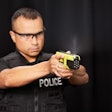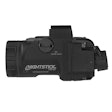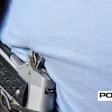There can be no denying that Smith & Wesson's Military & Police (M&P) pistol has been wholeheartedly accepted by law enforcement agencies both here in the United States and overseas. So what could S&W do to make this popular pistol even more popular?
Before we attempt to answer this question-and for the benefit of those who haven't been exposed to them yet-let's look at the technical aspects of the M&P.
Fit and Finish
M&P pistols have slides and barrels made from stainless steel that are through hardened, a process that produces both external and internal hardening. The barrels also feature cone muzzles for consistent positioning, which enhances accuracy and produces less friction as the slide travels to the rear. A half moon cut at the rear of the chamber hood allows the shooter to verify whether or not there is a cartridge in the chamber.
Both the slide and barrel receive S&W's proprietary Melonite finish, a heat treated process which penetrates into the metal itself, providing enhanced protection from wear, tear, solvents, and salts. The Melonite finish combines with the through hardening process to produce a surface hardness of 68 Hrc.
Novak Lo-Mount sights are standard on the M&P although Trijicon night sights are available as an option. The front of the slide has a tapered profile to ease re-holstering, especially when the task has to be performed one-handed, while deep cut grasping grooves ensure positive slide retraction, even with wet hands or when wearing gloves. The full-length, stainless steel guide rod and captive recoil spring ensure smooth operation and consistent lockup.
Engineering on the M&P is impeccable. The barrel and slide are locked together by the barrel hood bearing on the front of the ejection port. Upon firing, both parts recoil together for a short distance, whereupon the barrel is cammed down, allowing the slide to continue to the rear, extracting and ejecting the spent cartridge case. The recoil spring then pulls the slide forward, stripping the next round out of the magazine and chambering it. As the slide and barrel go into battery, the barrel hood moves up into the ejection port, locking the two units together.
Designed for Comfort
The M&P's ergonomics are also impressive. An extended beavertail secures the pistol in the shooter's hand and dissipates recoil, allowing fast follow-up shots. There are three interchangeable palm swells so the shooter can adapt the pistol to his or her particular hand size.
The M&P's Zytel frame has four steel rails in the frame-mounted locking block and sear housing that provide strength while reducing torque, frame flex, and felt recoil. They are shaped so that they not only reduce friction to improve functioning but clean debris out of the frame rail grooves.
Ambidextrous slide stop levers on the M&P have a flat profile to lessen the chances of the shooter engaging them unintentionally. The magazine release button can be switched to the starboard side to accommodate the southpaws among us.
The M&P's double-action-only trigger provides a smooth trigger stroke during which it retracts the striker before tripping the sear. Trigger pull is exactly the same for each shot, providing consistency and accuracy.
Besides the safety provided by the M&P's long trigger stroke, the design also includes trigger, firing pin, and magazine disconnect safeties. The trigger safety prevents movement until the pivoting trigger is pulled while a spring loaded plunger prevents firing pin movement until the rearward movement of the trigger bar deactivates it.
Removing the magazine allows a lever at the rear of the magazine well to pivot forward, which moves the trigger bar out of alignment with the sear, making it impossible for the pistol to be fired. Reinserting the magazine realigns these two units, permitting the pistol to be fired by a normal pull of the trigger. Note: The M&P can be ordered with or without the magazine safety.
To disassemble the M&P, the slide must be locked open and a sear deactivation lever at the rear of the mag well rotated forward. This means that the trigger does not have to be pulled to remove the slide from the frame. All M&P pistols have a Picatinny rail on the dust cover, which accepts all standard tactical lights and laser sights.
Now all of the above sounds pretty good to most shooters. But...as with most products, there were customers who wanted improvements on the basic M&P design. Which brings us to the subject under discussion.
Adding a Safety
While the M&P is replete with safeties, they are all passive devices that are deactivated simply by pulling the trigger. Such systems are not good enough for some agencies. They insist that any pistol carried by their officers include a manually operated safety device and, as behooves any manufacturer in a capitalistic economy, S&W set about providing just such a pistol.
The modifications to the basic design were simple. A bar with ambidextrous, serrated safety levers was installed between the magazine well and sear housing. When the safety levers are flipped up into the "on" position, an L-shaped extension on the right side is placed behind the trigger bar preventing it from moving.
An extra security feature of this system is that it does not immobilize the slide, allowing the pistol to be loaded or unloaded without moving the safety levers to the "off" position.
Ambidextrous safety models are available in full-sized 9mm, .357 SIG, .40 S&W, and .45 ACP caliber pistols and compact 9mm, .357 SIG, and .40 S&W pistols.
Range Time
S&W provided me with a safety equipped M&P9 to evaluate for POLICE. As I own several M&Ps I did not find much about it to remark upon, which to my way of thinking is a good thing.
One nice thing about the M&P pistol line is that no matter which model, size, or caliber pistol you have, the operating drill and disassembly procedure is exactly the same. In other words, if you know how to use one.....you know how to use all of them. This can come in very handy when training and if officers find it necessary to carry different models for specific assignments.
The safety levers were smooth in operation but held their positions very positively. When engaged or disengaged they produced a very audible "click," which serves to give the shooter further indication of the pistols' condition, even under stress. They also allowed me to fire the pistol with my favored "high thumb" grip which has the added benefit of holding the safety lever in the "off" position.
I test fired the M&P with five different brands of 9mm ammunition and it proved both pleasingly accurate and 100 percent reliable. Running offhand drills with it from five, 10, and 15 yards, I was further impressed with the pistol's innate ergonomics which I improved by fitting the medium size palm swell. Once again it proved completely reliable, even when fired with a weak hand, unsupported grip.
All in all, I found the new M&P to be an eminently suitable service pistol and the manual safety adds that little bit of extra security that many shooters will find reassuring.
Paul Scarlata has served as an auxiliary police officer and is a frequent contributor to POLICE.

















